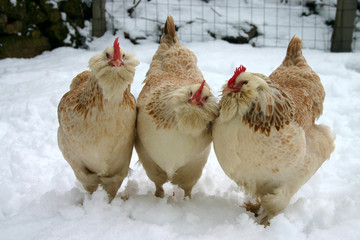Should I Heat My Chicken Coop?
You might be asking yourself, or your chicken-owning friends, if you should be heating your chicken coop. While there are many conflicting viewpoints, the answer, ultimately, is no. While egg production might drop during periods of colder temperatures, most backyard chicken owners still report birds laying an egg per day in temperatures well below freezing.
Chickens, like other poultry and fowl, are perfectly capable of self-heating in a variety of ways. They have built-in down coats and puff themselves up during times of cold to maximize the insulative value of their feathers. Additionally, chickens are known to snuggle up close to their flockmates during colder periods. Many of the variables surrounding bird warmth depend on bird breed, and thus their size, as well as the type of their combs.

Generally, larger chickens are more cold-hardy, mostly due to their body heat. The larger the bird, the more flesh they have, and therefore, the more body heat they produce. However, some smaller birds, such as the Brahma Bantam, are cold-hardy. The type of combs your chickens have also impact their ability to withstand cold temperatures. Combs that sit close to the head, such as pea combs, rose combs, and walnut combs, can withstand colder temperatures. However, single combs and combs that stand taller may be subject to frostbite. Chickens with large combs, such as leghorns, are also not considered cold-hardy as they have a large amount of unprotected and uninsulated surface area on the top of their head.
Decisions about heating and insulation should also be made while considering the size of your flock. If you have only a few chickens, they might need more help with warmth. Chickens huddle together and the body heat of 25 chickens is like having a 400-watt heater in your coop. If you want to figure out how much "chicken heat" your coop has, multiply the weight of your chickens in pounds by 8 BTUs. For example, if your pullets weigh approximately 6 lbs each, 6 lbs x 4 birds = 24 lbs for the flock. Multiply that by 8 BTUs. If your chickens weigh ~6 lbs each on average, then the 4 chickens put out 192 BTUs per hour, which is about the same as a 56-watt heater.
If you conclude that your chickens are not producing enough heat themselves, there are many things to be wary of when trying to introduce more heat into your coop. The risk of coop fires due to improperly used or mounted heating elements, or faulty heating elements, is tremendous. This includes a wide variety of heating devices, most especially heat lamps. Additionally, chickens need time to acclimate to temperatures. This means that if your heating element were to die without you noticing, especially overnight, your entire flock may go into shock, suffer from hypothermia, and die.
The best method of ensuring your chicken is warm is through insulating the coop. Whether you have insulation installed or you do it yourself, you must ensure that all of the insulation is covered before allowing your chickens inside. Chickens will peck at fiberglass and styrofoam insulation which can lead to death.
Air circulation is vital in your coop. Chickens need constant fresh air to remain healthy. Otherwise, dust, ammonia, moisture, and carbon dioxide build-up, causing health issues. This ventilation mustn’t cause drafts to flow through the coop, however. Cold drafts on chickens will disrupt their feathers, causing them to lose the warm pocket of air next to their skin. Ventilation holes should be cut into the coop at the very top where the walls meet the ceiling, allowing for air circulation without the chickens being blown on.
You should also ensure that your roosts are the proper size. The roost needs to be long enough for multiple chickens to sit on it together so they can benefit from the combined body heat. It also needs to be big enough in diameter to keep its feet warm. When chickens roost in winter, they puff out their feathers and cover their feet with them to keep warm. If the roost is too small in diameter, the chicken can wrap its whole foot around the roost, their toes will be unprotected. Many people like to use 2×4’s for roosts as the flat side allows the chickens to completely cover their feet while roosting.
There are many ways to ensure that your flock is warm without risking their safety. If you have questions about the best way to go about that, come see the team at the Essex County Co-Op!
